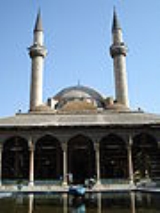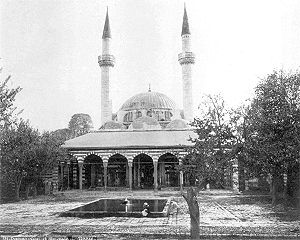
Tekkiye Mosque
Encyclopedia
The Tekkiye Mosque is a mosque
complex in Damascus
, Syria
, located on the banks of the Barada
River. The complex is composed of a large mosque on the southwest side of a courtyard, flanked by a single line of arcaded cells, and a soup kitchen across the courtyard to the northwest, flanked by hospice buildings.
and designed by the architect Mimar Sinan between 1554 and 1560. A separate madrasa (Al-Salimiyah Madrasa
) was added to the southeast of the Tekiyya complex by Selim II
and is linked to the Tekiyya complex with a souk. Hospices were built around the mosque to accompany dervish
es, known for their religious chants and whirling dances. It has been described as "The finest example in Damascus of Ottoman architecture".
capitals. The portal niche, centered on the portico façade, is topped with an elaborate muqarnas crown and framed with a band of geometric motifs.
is located below a series if muqarnas formations and is defined by marble mosaics, while the minbar
is made of white marble. There are plaster windows with colored pieces of glass on each of the four walls that open up towards the gardens. The exterior walls of the mosque are built of alternating rows of black and white stones. Colored marble facings were also used on the portico façade.
 At either side of the mosque are rows of six arcaded cells, equipped with fireplaces and covered with domes taller than the domes of the mosque portico. Located across the courtyard, the soup-kitchen also consists of a line of six equal-size cells, enlarged into a room at the center with two vaulted bays projection northeast. It faces the courtyard with a portico of twelve small domed bays. Placed lengthwise at either side of the soup kitchen are identical hospice buildings, composed of fourteen domed cells arranged in two rows. The hospice and the soup kitchen share a private courtyard behind the soup kitchen that is accessed with two gates from the main takiyya courtyard.
At either side of the mosque are rows of six arcaded cells, equipped with fireplaces and covered with domes taller than the domes of the mosque portico. Located across the courtyard, the soup-kitchen also consists of a line of six equal-size cells, enlarged into a room at the center with two vaulted bays projection northeast. It faces the courtyard with a portico of twelve small domed bays. Placed lengthwise at either side of the soup kitchen are identical hospice buildings, composed of fourteen domed cells arranged in two rows. The hospice and the soup kitchen share a private courtyard behind the soup kitchen that is accessed with two gates from the main takiyya courtyard.
Outside, the buildings in the courtyard were originally built to house the Dervishes, a spiritual sect of Muslims who are famed for their trance-induced whirling dance. It was later used as a Khan to house pilgrims who were making their way to the holy city of Mecca.
On the eastern side of the mosque is a Quranic school called the Selimiye Madrasa, built in the 16th century. The prayer room of the school is still used to teach the Quran. The buildings surrounding the school currently house all types of craftsmen, working in glass, copper, silver and textiles.
A military museum in the complex exhibits ancient weaponry and combat tools, many of which were used in the Crusades.
The entire complex was restored in the 1968 by the Directorate General of Antiquities.
Mosque
A mosque is a place of worship for followers of Islam. The word is likely to have entered the English language through French , from Portuguese , from Spanish , and from Berber , ultimately originating in — . The Arabic word masjid literally means a place of prostration...
complex in Damascus
Damascus
Damascus , commonly known in Syria as Al Sham , and as the City of Jasmine , is the capital and the second largest city of Syria after Aleppo, both are part of the country's 14 governorates. In addition to being one of the oldest continuously inhabited cities in the world, Damascus is a major...
, Syria
Syria
Syria , officially the Syrian Arab Republic , is a country in Western Asia, bordering Lebanon and the Mediterranean Sea to the West, Turkey to the north, Iraq to the east, Jordan to the south, and Israel to the southwest....
, located on the banks of the Barada
Barada
The Barada is the main river of Damascus, the capital city of Syria. It flows through the spring of `Ayn Fijah , about 27 km north west of Damascus in the Anti-Lebanon Mountains, but its source is Lake Barada, located at about 8 km from Zabadani...
River. The complex is composed of a large mosque on the southwest side of a courtyard, flanked by a single line of arcaded cells, and a soup kitchen across the courtyard to the northwest, flanked by hospice buildings.
History
It was built on the orders of Suleiman the MagnificentSuleiman the Magnificent
Suleiman I was the tenth and longest-reigning Sultan of the Ottoman Empire, from 1520 to his death in 1566. He is known in the West as Suleiman the Magnificent and in the East, as "The Lawgiver" , for his complete reconstruction of the Ottoman legal system...
and designed by the architect Mimar Sinan between 1554 and 1560. A separate madrasa (Al-Salimiyah Madrasa
Al-Salimiyah Madrasa
Al-Salimiyah Madrasa is a madrasah in Damascus, Syria. The madrasa was built as a part of the Tekkiye Mosque complex in a separate building to the southeast of the complex...
) was added to the southeast of the Tekiyya complex by Selim II
Selim II
Selim II Sarkhosh Hashoink , also known as "Selim the Sot " or "Selim the Drunkard"; and as "Sarı Selim" or "Selim the Blond", was the Sultan of the Ottoman Empire from 1566 until his death in 1574.-Early years:He was born in Constantinople a son of Suleiman the...
and is linked to the Tekiyya complex with a souk. Hospices were built around the mosque to accompany dervish
Dervish
A Dervish or Darvesh is someone treading a Sufi Muslim ascetic path or "Tariqah", known for their extreme poverty and austerity, similar to mendicant friars in Christianity or Hindu/Buddhist/Jain sadhus.-Etymology:The Persian word darvīsh is of ancient origin and descends from a Proto-Iranian...
es, known for their religious chants and whirling dances. It has been described as "The finest example in Damascus of Ottoman architecture".
Architecture
The mosque is formed by a wide portico and a sixteen meter square prayer hall that is covered with a large Ottoman dome. The portico is composed of three domed cells wrapped with a sloping lead roof carried on twelve columns. Its marble and granite columns carry diamond-cut and muqarnasMuqarnas
Muqarnas is a type of corbel used as a decorative device in traditional Islamic architecture. The term is similar to mocárabe, but mocárabe only refers to designs with formations resembling stalactites, by the use of elements known as alveole.Muqarnas takes the form of small pointed niches,...
capitals. The portal niche, centered on the portico façade, is topped with an elaborate muqarnas crown and framed with a band of geometric motifs.
Interior
Inside, the dome displays a ring of apertures along the elongated base and is covered with lead on the outside. Four arches that extend from the thick walls support the dome. The transition zone from dome to wall is formed by using circular stone triangulations without any muqarnas. The mihrabMihrab
A mihrab is semicircular niche in the wall of a mosque that indicates the qibla; that is, the direction of the Kaaba in Mecca and hence the direction that Muslims should face when praying...
is located below a series if muqarnas formations and is defined by marble mosaics, while the minbar
Minbar
A minbar is a pulpit in the mosque where the imam stands to deliver sermons or in the Hussainia where the speaker sits and lectures the congregation...
is made of white marble. There are plaster windows with colored pieces of glass on each of the four walls that open up towards the gardens. The exterior walls of the mosque are built of alternating rows of black and white stones. Colored marble facings were also used on the portico façade.
Minarets
Two tall cylindrical minarets rise atop the east and north corners of the mosque's portico wall. They are made of white stone and crowned with conical roofs. Both minarets have one balcony supported by stone muqarnas for the muezzin to sound the call to prayer.The complex

Outside, the buildings in the courtyard were originally built to house the Dervishes, a spiritual sect of Muslims who are famed for their trance-induced whirling dance. It was later used as a Khan to house pilgrims who were making their way to the holy city of Mecca.
On the eastern side of the mosque is a Quranic school called the Selimiye Madrasa, built in the 16th century. The prayer room of the school is still used to teach the Quran. The buildings surrounding the school currently house all types of craftsmen, working in glass, copper, silver and textiles.
A military museum in the complex exhibits ancient weaponry and combat tools, many of which were used in the Crusades.
The entire complex was restored in the 1968 by the Directorate General of Antiquities.

